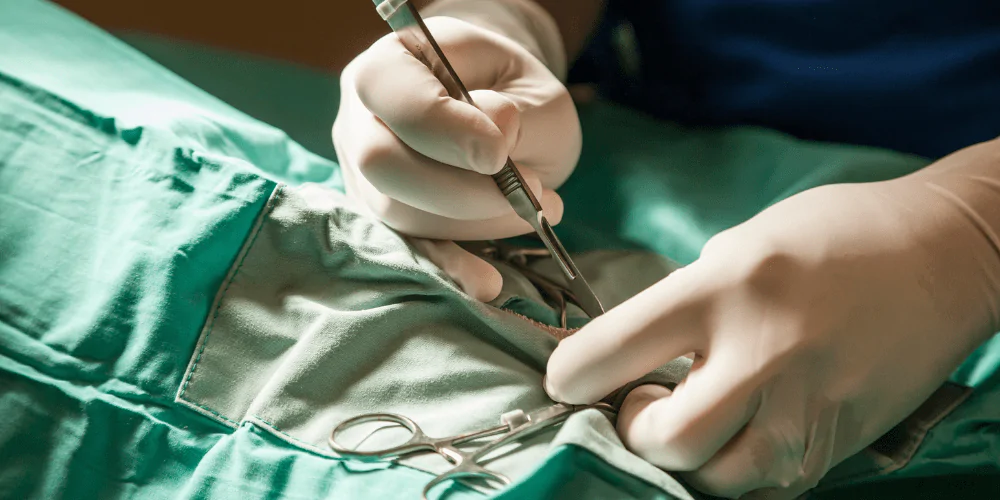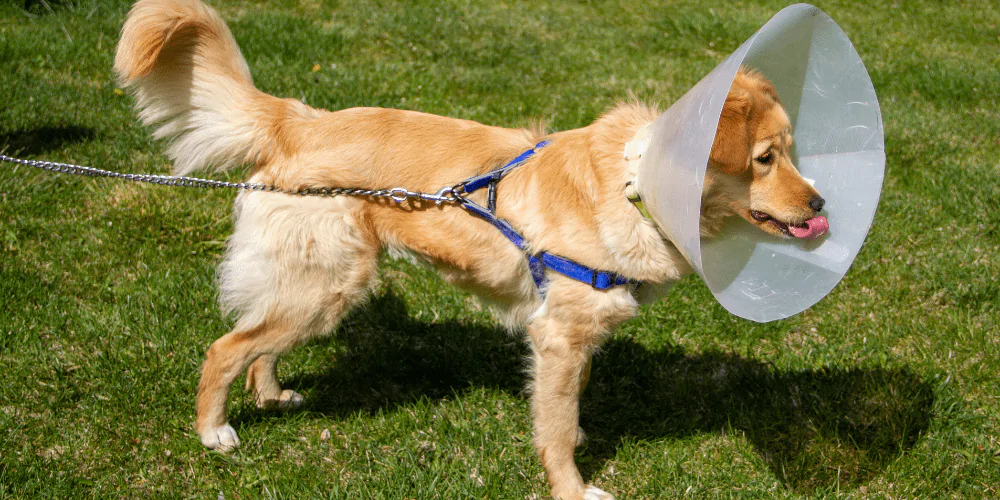
Female dog neutering: Your guide to spaying and behaviour

Philippa Short
28 February 2023 | 7 minutes read
Spaying is a big decision for any pet parent. But did you know that how you time your pup’s neutering can also have a big impact on their future behaviour? Expert dog behaviourist Philippa Short explains the ins and outs of spaying, so you can decide what’s best for your pooch.
- What is female dog neutering?
- What are my options for spaying my dog?
> How much does it cost to spay a dog in the UK? - Dog neutering aftercare
> How long does it take for a dog to recover from being spayed? - Should I get my female dog neutered?
> Will spaying calm a female dog? - At what age should a female dog be spayed?
> At what time in their cycle should a female dog be spayed?
> What behavioural problems are caused by spaying at the wrong time?

What is female dog neutering?
Neutering a female dog (known as spaying) is a way to stop them from getting pregnant or having phantom pregnancies. It can also reduce the risk of your girl developing certain infections and cancers.
Spaying is carried out by a vet and involves surgically removing some or all of your pup’s reproductive organs.

What are my options for spaying my dog?
There’s three types of dog spaying and all need surgery:
- Taking away the ovaries but leaving the uterus
- Taking away the uterus but leaving the ovaries
- Doing a full ovariohysterectomy (which takes both the uterus and ovaries)
Before the surgery:
- You’ll be asked to not let your dog have any more food after a certain time – usually from midnight the night before surgery, but let your vet guide you on this
- They’ll be taken in and given a light medication to make them sleepy
- Your female will then be put under a full anaesthetic
There’s two types of spaying surgery: classic and keyhole (which is a newer option but slowly becoming more common).
The classic way of doing spaying surgery involves:
- An incision in the belly where the surgeon will go through the various layers and then perform the spay
- Closing up the incision with several layers of internal dissolvable stitches
- Surgical glue or stitches on the outside skin to finish
Your pup will then be taken into recovery to come round from the anaesthetic. If all goes well, you should be able to pick her up later that day and take her home.
> How much does it cost to spay a dog in the UK?
The cost to spay your dog varies based on their breed and your individual vet.
Get in touch with your local vet practice to find out how much they charge. For example, dog spaying costs at this Northampton-based vet practice start from £244 (as of 23 February 2023, discounted for registered pet health club members).
As spaying and neutering are classed as preventative care, you won’t typically be able to claim on your dog insurance policy. But if you need help covering the costs, some dog charities have schemes you can access.

Dog neutering aftercare
Aside from plenty of careful cuddles when she wants them, your girl needs to be:
- Kept very calm and quiet
- Put on a lead and gently taken out into the garden if she wants to relieve herself
- Stopped from licking her wounds or stitches, as this can lead to infection and delay recovery.
Depending on how determined your dog is to reach her stitches, you can use an Elizabethan collar, doughnut collar, or vest.
> How long does it take for a dog to recover from being spayed?
Your pup will have a check up three days after surgery (and again at 10 days post-surgery if surgical glue was used). Her stitches come out around 10-14 days after surgery.
You can start building your dog back up to her previous fitness levels from day 10 post-surgery.
Spaying recovery time can vary if your pup is too active too soon or is able to get at her stitches.

Should I get my female dog neutered?
Your dog is unique, so the choice to spay is completely based on your individual circumstances.
Before deciding, think about your home environment as well as your dog’s breed and health.
- Do you have intact male dogs in the house?
- Does your garden have low fences that other male dogs could jump?
- Is there somewhere you can safely exercise your female pup away from males, such as enclosed dog fields?
- Does your dog’s breed have a higher risk of reacting to anaesthetics? (If unsure, check with your vet)
- How severe are your pup’s phantom pregnancy symptoms?
Some benefits of spaying include:
- Stopping your pup from being able to get pregnant
- Preventing phantom pregnancies
- Reducing the possibility of your dog getting a serious womb infection (pyometra) in later life
- Slightly reducing the risk of your dog getting a mammary tumour
> Will spaying calm a female dog?
Dog behaviourists will likely recommend spaying if a female dog shows increased reactivity and aggression only around the time of their season.
Generally, spaying won’t improve negative behaviour. In fact, it may actually make things worse if she’s:
- Always highly reactive (no matter where she is in her cycle)
- Acting male (cocking her leg, frequently urine marking)
- Showing confident aggression
Under confident or generally fearful dogs (of public places, people, being handled) first need behaviour modification. This will help to reduce their fearfulness before being spayed.
Let her have a few seasons, bring up her confidence levels with being handled, then come back to spaying.

At what age should a female dog be spayed?
Vets may take two approaches when recommending the timing of spaying:
- The traditional advice – spay before your dog’s first season or to time it for 12 weeks after the end of their season.
- The newer approach – try and spay as close to her next season as possible. This should be at least four months from the end of her last season. But this can be difficult to time if you haven’t learned your dog’s heat cycle and frequency.
Behaviourists will always warn against spaying before the first season or 12 weeks from the start of the season, as a mistimed spay can cause lifelong problems. Your pup needs her hormones through adolescence to properly grow and mature.
It’s recommended to wait at least three months (preferably four) from the end of the season or as near to the next season as possible. But this relies on you know the timings of your girls’s cycle.
Dr Caroline Warnes MRCVS is a retired vet and certified clinical behaviourist who has done pioneering research on pseudopregnancy. She advises that most dogs benefit from having at least one season, especially if they are:
- Larger breeds
- Prone to osteosarcoma and joint problems
- Prone to urinary tract and incontinence problems
- Struggling with a recessed vulva or vaginal dermatitis
- Active performance dogs (involved in activities like agility and flyball)
Having their first season allows their joints to grow properly and their vulva to develop better.
The only time you should think about spaying before their first season is if:
- They live with another female dog who’s very similar in age or breed
- There’s already signs of tension with another female in the house
The higher hormone levels during a season can increase aggression. Spaying may stop the hormone flares in these situations, but keep in mind there’s no guarantees.

> At what time in their cycle should a female dog be spayed?
Learning how regularly your dog has her cycle can help you know when her next season is due, and so time her spaying appropriately.
If she’s in season or coming up to her season, her area will be engorged with blood and the blood vessels larger, making surgery more complicated.
Whether she’s showing physical or behavioural signs, you should never spay a female dog having a phantom pregnancy. This can lock them into the cycle and cause massive behavioural problems.
Vet behaviourist Dr Caroline Warnes recommends spaying at the correct time if a female dog has severe behavioural changes with false pregnancy. Sometimes you’ll need to medicate the pup for phantom pregnancy to make sure it’s completely finished, then you can spay.

> What behavioural problems are caused by spaying at the wrong time?
Spaying when your pup is in the middle of a phantom pregnancy can lock her into that physical and emotional state.
Sometimes she can show physical or behavioural signs of phantom pregnancy days after being spayed because her hormonal flow has been interrupted.
If you don’t wait for the phantom pregnancy to end before spaying, it can lead to:
- Aggression (including with other females)
- Anxiety
- Depression
- Physical problems
- Resource guarding
She can also show aggression or anxiety for weeks and years after being spayed during a phantom pregnancy.
If you’re worried your female dog has gone through misplaced spaying and has new or increased behavioural problems, reach out to a dog behaviourist. She will need to be treated with medication, which can be given up to three years after spaying and still take full effect.
Protect your pup throughout their adolescent years with flexible dog insurance from Petsure.


